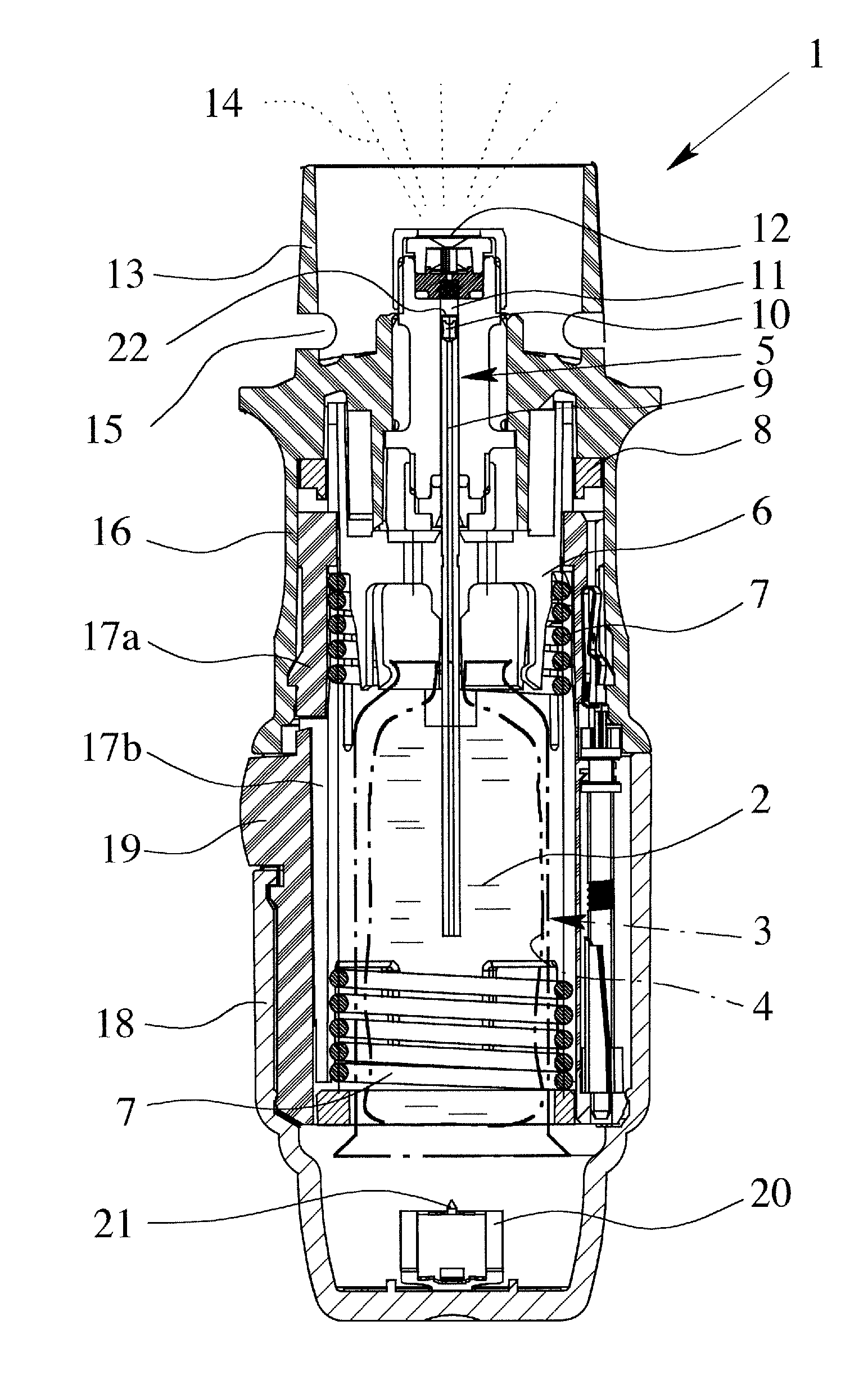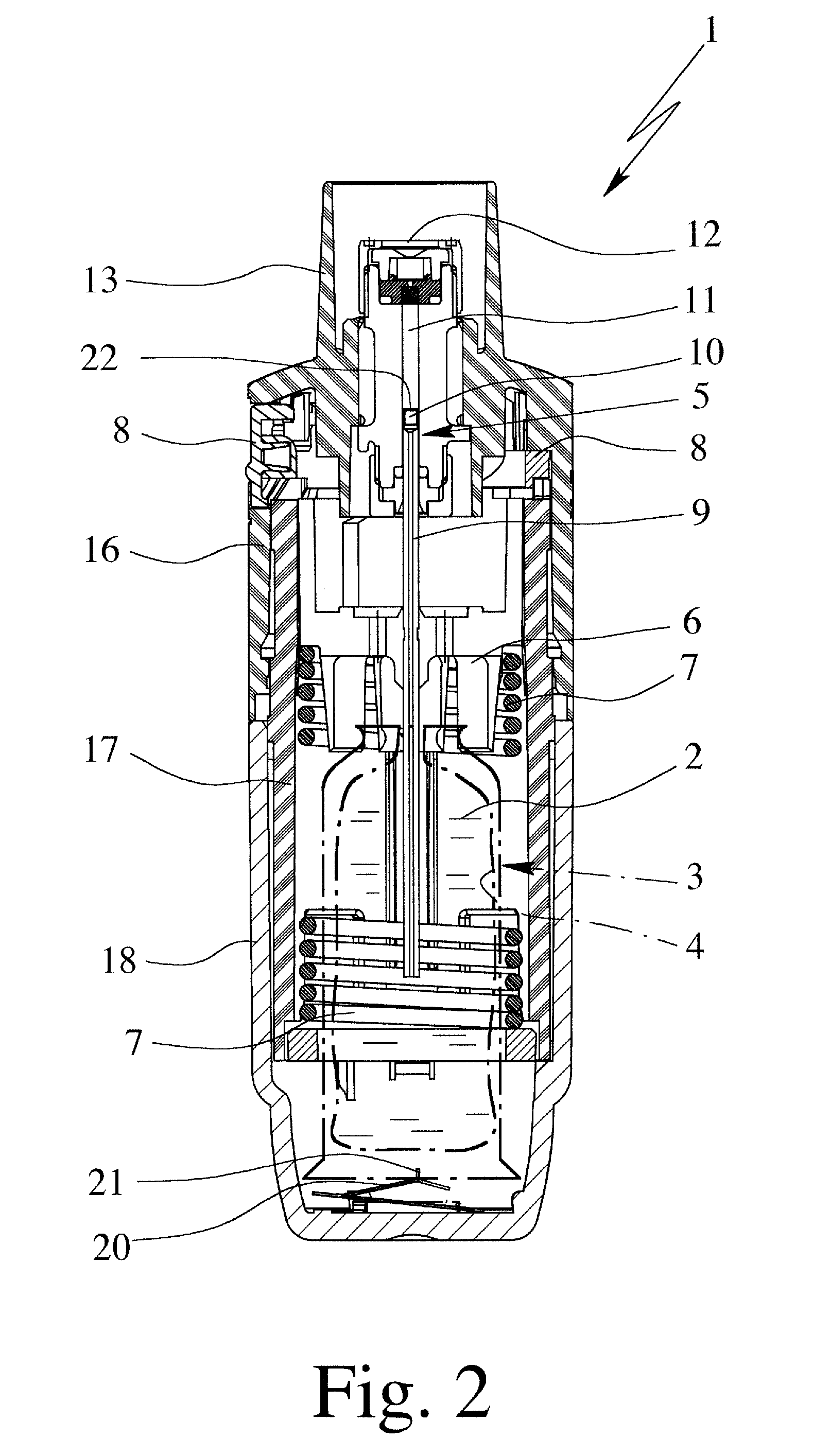Nebuliser
a technology of nebuliser and fluid, which is applied in the direction of respirator, single-unit apparatus, separation process, etc., can solve the problems of difficult production, small manufacturing tolerance, and thick wall of capillaries, and achieves simple and inexpensive production and great stability.
- Summary
- Abstract
- Description
- Claims
- Application Information
AI Technical Summary
Benefits of technology
Problems solved by technology
Method used
Image
Examples
first embodiment
[0045]FIG. 3 shows, in schematic section, the container 3 and part of the associated proposed nebuliser 1 according to a The conveying tube 9 comprises an inner tube 23 and an outer tube 24, which are preferably, arranged concentrically to one another and / or formed as thin walled, in particular standard commercial capillaries.
[0046] The conveying tube 9 is thus double walled and preferably, multi-part in construction and especially is in the form of a thick walled but preferably, not massive capillary. The double walled and particularly, multi-part construction makes it possible in particular to manufacture the conveying tube 9 particularly, cheaply and / or precisely, most preferably, with a smooth and / or round inner wall or contour.
[0047] The inner tube 23 forms a conveying channel 25 on the inside. The annular space 26 between the inner tube 23 and the outer tube 24 preferably, forms a venting channel in the first embodiment. Alternatively, the annular chamber 26 may also prefera...
second embodiment
[0063] In the second embodiment, the valve seat 33 is, preferably, formed by a concentric region or section of the outer tube 24, particularly, an encircling narrowing or bead 34. However, other constructive solutions are also possible.
[0064] The inner tube 23 preferably, has a radially widening, particularly, at least partially conical connecting portion 35 which, in this case, is formed at the end of the inner tube 23 and expands, in particular, at least substantially to the inner diameter of the outer tube 24. The two tubes 23, 24 are joined together by the connecting portion 35, particularly, by welding, gluing or the like. For example, it is possible to carry out welding through the outer wall of the outer tube 24 in a substantially radial direction.
[0065] Thus, the inner tube 23 extends at least substantially as far as the valve seat 33 or up to the preferably, radial narrowing or bead 34, thus minimising the volume through which the fluid 2 can flow in the conveying tube 9 o...
fourth embodiment
[0076]FIG. 11 shows, in an enlarged detail from FIG. 8, the retaining region 27 of the conveying tube 9. Instead of a projection, the retaining region 27, in this fourth embodiment, preferably, has a radial indentation or recess 37 particularly, an annual groove, a step, a bead or the like, several of which may be provided one behind the other and in particular a corrugated outer contour may be formed by the retaining region 27.
[0077] According to a particularly, preferred aspect, the outer tube 24 at the retaining region 27 is deformed axially inwards such that it bears on the inner tube 23. If necessary, the outer tube 24 in this contact region may also be fixedly connected to the inner tube 23, e.g., by welding or adhesive bonding. This can contribute to the overall stability of the conveying tube 9. However, it is also possible for a radial spacing to be maintained between the outer tube 24 and the inner tube 23 at the retaining region 27.
[0078]FIG. 12 shows a fourth embodiment...
PUM
 Login to View More
Login to View More Abstract
Description
Claims
Application Information
 Login to View More
Login to View More - R&D
- Intellectual Property
- Life Sciences
- Materials
- Tech Scout
- Unparalleled Data Quality
- Higher Quality Content
- 60% Fewer Hallucinations
Browse by: Latest US Patents, China's latest patents, Technical Efficacy Thesaurus, Application Domain, Technology Topic, Popular Technical Reports.
© 2025 PatSnap. All rights reserved.Legal|Privacy policy|Modern Slavery Act Transparency Statement|Sitemap|About US| Contact US: help@patsnap.com



